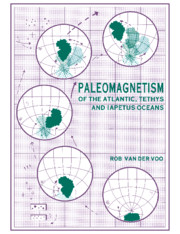Book contents
- Frontmatter
- Contents
- Preface and acknowledgements
- 1 Prologue
- 2 Paleopoles and paleomagnetic directions
- 3 Megaplates, microplates, blocks, terranes, accreted slivers, thrusts and olistostromes
- 4 Paleomagnetic information – what makes a paleopole valuable?
- 5 The major continents and Pangea
- 6 The opening of the Atlantic Ocean
- 7 The Tethys blocks
- 8 The terranes, blocks and adjacent continents of the Iapetus Ocean
- 9 Epilogue
- 10 Appendix
- References
- Index
3 - Megaplates, microplates, blocks, terranes, accreted slivers, thrusts and olistostromes
Published online by Cambridge University Press: 24 November 2009
- Frontmatter
- Contents
- Preface and acknowledgements
- 1 Prologue
- 2 Paleopoles and paleomagnetic directions
- 3 Megaplates, microplates, blocks, terranes, accreted slivers, thrusts and olistostromes
- 4 Paleomagnetic information – what makes a paleopole valuable?
- 5 The major continents and Pangea
- 6 The opening of the Atlantic Ocean
- 7 The Tethys blocks
- 8 The terranes, blocks and adjacent continents of the Iapetus Ocean
- 9 Epilogue
- 10 Appendix
- References
- Index
Summary
In the 40 years or so since the first paleomagnetic directions were obtained from rocks older than the last few million years, some 7000 paleopoles have been published for rocks from every imaginable location on Earth, with ages ranging from the very recent to the Archean. To bring some order to this wealth of data, it is necessary to divide the Earth's surface into geologic/geographic elements; the nature and definition of these elements form the subject of this chapter. If a paleopole is representative of the ancient geomagnetic dipole field at the time of rock formation, it is a valuable datum (Chapter 2) for the ancient geographic position of the rocks and its surroundings. What are these ‘surroundings’?
For a discussion of this, we need to look briefly at the paradigm of plate tectonics and its consequences for the structure of the crust. The present-day surface of the Earth is made up of about ten major lithospheric plates, many with continental as well as oceanic crust (e.g., the North American, South American, African, Indo-Australian, Eurasian, Caribbean and Antarctic plates), but a few with predominantly oceanic crust only (e.g., the Pacific, Cocos and Nazca plates). The plate boundaries are the relatively narrow zones where relative motions occur between the plates: these motions can be divergent, convergent or strike-slip (along transform faults). The interiors of the plates remain – in theory – undeformed and rigid. If this is true, then a paleopole is valid for the entire plate interior, its continental as well as its oceanic parts.
- Type
- Chapter
- Information
- Publisher: Cambridge University PressPrint publication year: 1993



